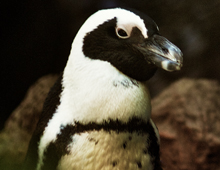Description: Black-footed penguins are also known as African or Jackass penguins. They have a narrow, horseshoe-shaped black band across the chest which extends down each side to the feet. The stomach and chest are speckled with black spots. A white throat bar begins at the base of the bill, continues over the eyes, around the cheeks and broadens at the upper breast. A pink patch of bare skin can be seen around the eyes, which allows excess heat to escape. A white band goes across both the upper and lower portions of the black bill; its legs and webbed feet are also black. Their coloration (countershading) makes it difficult to see them when they are swimming, blending into the sea from above and into the sky from below.
Size: Black-footed penguins are medium-sized, with adults weighing five to eight pounds (2.27 – 3.63 kg) and between 20-24 inches (51 – 61 cm) in height. On the average, females are slightly smaller than males and their beaks are also smaller.
Behavior: These highly social birds live in
small colonies called rookeries where they hunt together, often in groups of 50-100. In their native habitats, most Black-footed penguins that are not incubating or brooding, spend the day at sea. They are expert swimmers, “porpoising” in and out of the water to take in air without decreasing speed. Their average swimming speed is three to six miles per hour (5-10 kph) but they can reach speeds of 15- 20 mph (24-32 kph) for a short distance – if in a serious chase. They can hold their breath for three to five minutes. Assisting with their ease of swimming are the webbed feet, tail and legs that steer like rudders, and wings or “flippers” of these flightless birds that are modified for swimming. Much time is spent grooming and preening their short feathers. An oil gland at the base of the tail is used to spread oil over their plumage. Their dense and closely packed feathers (more than 70 per square inch) are layered, making them waterproof – enabling them to keep warm in cold water. In order to not become too hot when out of the water, they are able to pump blood to areas of their bodies that are less insulated, such as the bare skin on their face, feet and flippers. They also fluff out their feathers to release the heat. Unable to waterproof their feathers when molting, penguins stay out of the water during this time. Much fat must be deposited prior to the molt, which may last three weeks, and after the molt, they must again build up their fat reserve.
Diet: Black-footed penguins feed on small shoaling fish such as sardines and anchovies but will also eat squid and crustaceans.
Senses: Sense of hearing is excellent; eyes are adapted for vision under water.
Communication: Black-footed penguins have a loud squawking, donkey-like braying call used when mating (thus the name Jackass), often accompanied with the flapping of their flippers.
Reproduction: These monogamous penguins breed in nesting colonies. Their nests are constructed of excrement (guano) in burrows, where usually two greenish eggs are laid. Incubation is approximately 39 days. Both parents incubate, feed and care for the young. Chicks will stay in the nest until they molt and grow new feathers (approximately 30 days).
Habitat/range: These temperate/subtropical penguins inhabit rocky coastal areas and islands of southern and southwestern Africa.
Status: Classified by IUCN as Endangered (EN); CITES Appendix II. In addition to natural predators such as sharks and seals, commercial fishing, oil spills, and collection of their eggs and guano are serious threats. Included in AZA Species Survival Plan® (SSP). This program cooperatively manages specific, and typically threatened or endangered populations.



